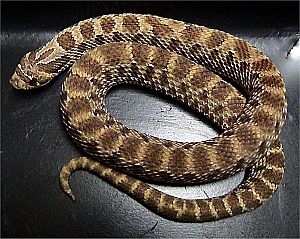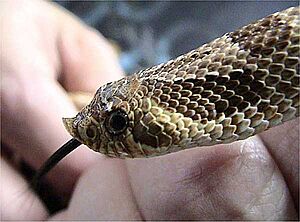Western hognose snake facts for kids
Quick facts for kids Western hognose snake |
|
|---|---|
 |
|
| Western hognose snake | |
| Conservation status | |
| Scientific classification | |
| Genus: |
Heterodon
|
| Species: |
nasicus
|
The western hognose snake (Heterodon nasicus) is a type of snake that lives only in North America. It belongs to the Colubridae family of snakes. These snakes are not venomous in a way that is dangerous to humans.
Contents
What's in a Name?
The name nasicus comes from a Latin word meaning "nose." This is because the western hognose snake has a special nose scale that turns upwards, looking a bit like a pig's snout!
Some parts of the snake's scientific name also honor people. For example, gloydi is named after an American snake expert named Howard K. Gloyd. Another name, kennerlyi, honors a naturalist named Caleb Burwell Rowan Kennerly.
Cool Nicknames
People call the western hognose snake by many different names! Some common ones include:
- blow snake
- bluffer
- faux viper (which means "fake viper")
- plains hognose snake
- prairie hognose snake
- spoonbill snake
- spreadhead snake
- Texas hognose snake
- Texas rooter
About Its Look and Size
The western hognose snake is a small, sturdy snake. Its colors and patterns can change a lot, but many of them look a bit like rattlesnakes. This helps them trick predators into thinking they are more dangerous than they are.
Male western hognose snakes are much smaller than females. Adult males are usually about 15 to 20 inches (38 to 51 cm) long. Females are larger.
The snake gets its "hognose" name from its unique nose. This upturned nose scale helps them dig very well in the ground.
These snakes are not dangerous to people. While they do have a mild toxin in their saliva, it's mostly for their prey, like toads. There have been no reports of serious harm or deaths from a western hognose snake bite. They are not considered venomous to humans.
In captivity, people have bred these snakes to have many different colors and patterns. There are about 52 "designer" color types!
Where They Live
Western hognose snakes can be found from southern Canada all the way through the United States to northern Mexico. They like places with sandy or gravelly soil. This includes prairies, river areas, grasslands, and even some semi-desert regions. They can live in high places, up to about 8,200 feet (2,500 meters) above sea level.
How They Act
Daily Life and Defense
Western hognose snakes are mostly active during the day. They are usually calm snakes, but some can be quite defensive if they feel scared.
If a western hognose snake feels threatened, it has some amazing tricks:
- It might flatten its neck, making it look wider, a bit like a cobra.
- It can hiss loudly.
- It might make "bluff strikes." This means it lunges at you with its mouth closed, pretending to bite.
- If it's still bothered, it will almost never bite. Instead, it will usually "play dead"! It might flip over, open its mouth, and even release a smelly fluid to make predators think it's really dead.
Sometimes, especially younger male snakes, might puff up their throats with air instead of flattening their heads.
What They Eat
In the wild, western hognose snakes mainly eat amphibians. Their favorite foods are large and medium-sized tree frogs and toads. They also eat small lizards. Sometimes, they might eat a rodent too.
Unlike snakes that squeeze their prey (constrictors), the hognose snake bites and chews. They use their small back teeth to help their saliva get into the prey. This saliva helps break down toxins from toads, making them easier to eat.
If you have a hognose snake as a pet, you might notice it won't eat for a few months in winter (from January to mid-March). This is normal! It's because their natural instinct is to brumate (a type of hibernation) underground during the colder months.
Life Cycle and Reproduction
Western hognose snakes start mating as early as February or March. The female snake lays eggs, usually between 4 and 23 of them, in June or August. These eggs have thin shells and take about 60 days to hatch.
When they hatch, baby hognose snakes are about 5 to 9 inches (13 to 23 cm) long. They become old enough to have their own babies when they are about two years old, or when they reach a certain size.
Different Types of Western Hognose Snakes
There are a few different types, or subspecies, of the western hognose snake. Here are some of them:
| Subspecies | Common name | Where it lives |
|---|---|---|
| H. n. gloydi | Gloyd's hog-nosed snake | Southeastern Kansas and Missouri, eastern Oklahoma, and most of Texas. |
| H. n. kennerlyi | Mexican hog-nosed snake | Mexico (from Tamaulipas to San Luis Potosí), and parts of the southwestern United States like New Mexico and Arizona. |
| H. n. nasicus | Plains hog-nosed snake | The Texas panhandle, New Mexico, north through western Oklahoma and Kansas to parts of Canada (like Manitoba and Saskatchewan). Also found in prairies in Minnesota and Illinois. |
Keeping Them Safe
The western hognose snake is found in many places and has a large population. Because of this, it is listed as a "Least Concern" species by the IUCN. This means they are not currently at high risk of disappearing.
However, another type of hognose snake, the eastern hognose snake (Heterodon platirhinos), is protected in some areas because its numbers have gone down.
See also
 In Spanish: Serpiente de hocico de cerdo occidental para niños
In Spanish: Serpiente de hocico de cerdo occidental para niños



